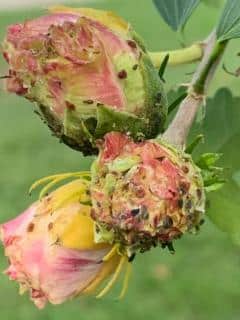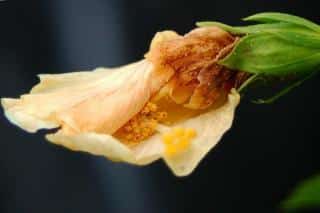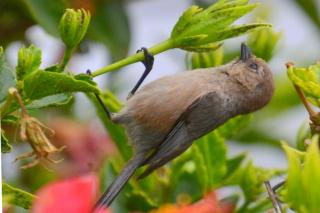

All the species and varieties of Hibiscus are vulnerable to aphids. Here are the symptoms of such an invasion, and how to treat it.
A flower shrub that tries to bloom but can’t because of little black insects on the flower buds deserves a little help, doesn’t it?
Name – Aphis sp., Calaphis sp. & others
Family – Aphididae
Lifespan – 1 month on average (unless hibernating)
Size – 1/16th to 1/8th inch (1 to 3 mm)
Symptoms – flowers fail to open, weak growth, sticky substance
Danger to plant – not fatal on hibiscus
Side effects – often associated with ants. Rarely transmits viral diseases
Beneficial – not a beneficial species
Appears in – spring & fall (year-round indoors)
Contagious – very (winged and carried by wind)
Treatment – hosing down & biocontrol
Hibiscus plants both grown outdoors and indoors are vulnerable to aphids.
Aphids tend to concentrate on portions of the shrub that have tender tissues. For Hibiscus, colonies typically appear on:
The tiny insects cluster around the most favorable spots. They secrete a sweet substance called honeydew.
Honeydew is essentially what’s left of the hibiscus plant’s sap once the insects are finished feeding from it. Many other insects take advantage of this honeydew themselves, since it still contains many nutrients. Ants often appear near aphids, and even bees are known to collect honeydew to feed on.

Flower buds are the most appealing part of the plant for aphids. The insects will tend to congregate there. In case of heavy rain, they might take refuge on the underside of leaves, which they can also feed from.
The buds tend to be covered in insects at all stages of maturity: small, light-colored younglings, large, brownish or blackish mother aphids, and even dry hulls of dead aphids that still cling to the plant. Usually these are all wingless, but some might have a pair of wings when colonies get larger.
In extreme cases, the bud will seem to be nibbled on and petals are twisted and clumped together in a roundish shape that doesn’t resemble the typical lance-shaped hibiscus flower bud at all.

Hosing the shrub down works well, too, but has to be repeated daily for about a week. Indeed, aphids hidden in buds aren’t washed away; repeating the task lowers their numbers to a manageable count.
Several plants developed biochemical weapons that repel ants: tansy, French lavender… Plant these nearby. There also lots of tips to get rid of ants or redirect them elsewhere here: dealing with ants in the garden naturally.

Even certain species of birds will help out! For instance, goldfinch will pick aphids off hibiscus with great gusto!
There are ways to hinder aphids from even appearing on your hibiscus. These methods will also slow the growth of aphid colonies.
You should know that Hibiscus isn’t the favorite host of aphids. Only small portions of the plant are appealing to aphids. This means that if provided with another more “tasty” plant, aphids will tend to migrate to that more appealing plant instead.
Typically, a plant like nasturtium is like a magnet for aphids. If you grow a couple nasturtium vines near your hibiscus plants, you won’t see many aphids on the shrubs anymore.
Moreover, the aphids on the nasturtiums will attract ladybugs, green lacewing and other beneficial insects that will of course cleanse your hibiscus from stray aphids on their way to the feast down below!
Some plants such as French marigold and lavender repel aphids naturally. Planting them immediately under and around your Hibiscus will also protect them, too.
It’s tempting to spray insecticides to get rid of the aphids. Spraying pesticides is very effective, but it has severe drawbacks for your garden in the long run.
Natural pesticides such as those based on pyrethrum (a Chrysanthemum extract) is much better than chemical and petroleum-based products.
However, such sprays kill blindly, wiping everything out and wrecking havoc in the plant’s own defense system. Indeed, it destroys the microscopic beneficial bacteria and fungus that live on leaves, leaving the plant completely bare. Other more aggressive fungus and bacteria can then easily infect your plant or its neighbors. And, of course, any beneficial insects will be wiped out as well.